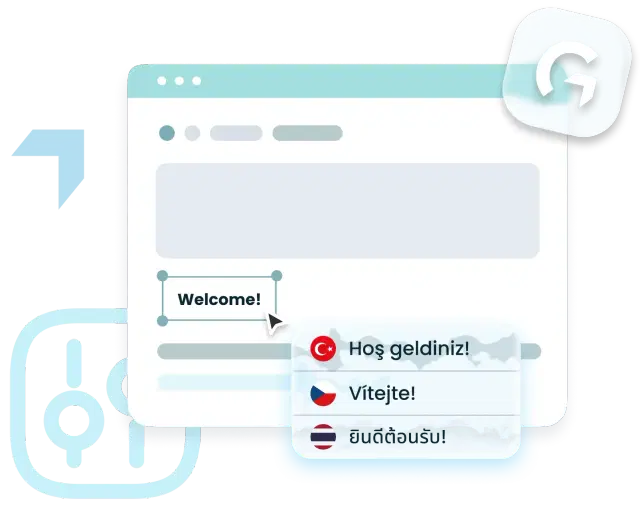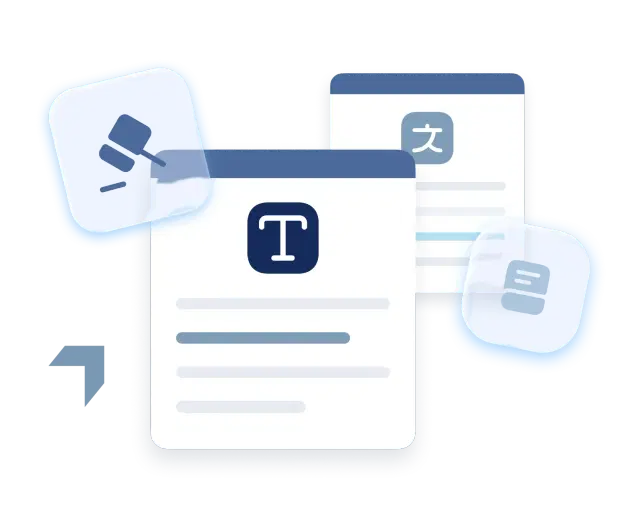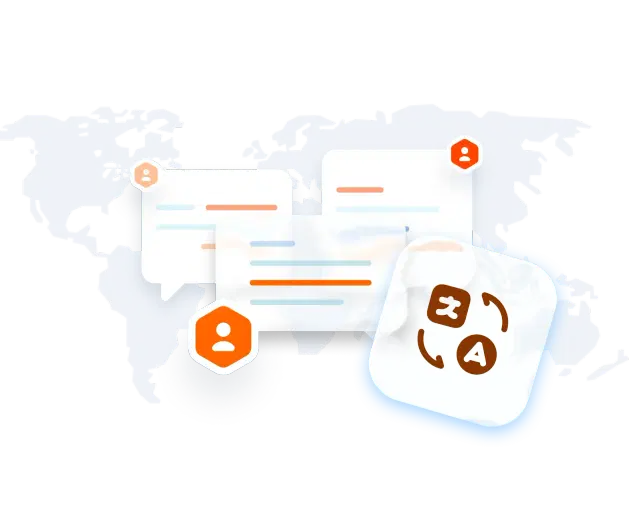Multilingual Websites: Glossary for Beginners
Multilingual Websites: Technical & Translation Terms Explained
Updated on September 17, 2025
If you’re preparing to translate your website into multiple languages, one of your first challenges will be navigating the technical jargon used by website translation services.
We know—it feels like learning a foreign language. And no, the irony isn’t lost on us.
To make this process easier, we’ve assembled a glossary of key terms to help you quickly understand multilingual website translation and make informed decisions.
Key Terms for Multilingual Website Translation
Active Monitoring Insert (AMI)
Active Monitoring Insert (AMI) refers to real-time monitoring of translation quality on a multilingual website. This can be done using software or human oversight, ensuring that translation issues are detected and corrected quickly.
For example, an AMI system might alert a translation team if a content mismatch or error is found on a published page, allowing for an immediate fix.
Automatic Content Detection
Automatic content detection is the process of identifying and extracting content from a website or app that requires translation. This might include text, images, and other media.
For instance, a content detection tool might scan a website and flag all text-based elements that need to be translated, ensuring nothing is overlooked.
Automatic Redirect
An automatic redirect directs visitors to the appropriate language version of a website based on their browser settings or IP address.
While this can improve user experience, it’s important to allow users to manually select their preferred language as well, since location-based assumptions aren’t always accurate.
Cookie
Cookies are small data files stored on a user’s device that help websites remember user preferences.
For multilingual websites, cookies can be used to remember the language a user selects, so they don’t have to choose it each time they visit.
DeepL
DeepL is a neural machine translation (NMT) engine known for producing high-quality translations that sound more natural than traditional machine translation.
For multilingual websites, DeepL can be used to automate translations, though human oversight is often needed to refine the final content..

DNS (Domain Name System)
The Domain Name System (DNS) translates human-readable domain names (e.g., example.com) into machine-readable IP addresses (e.g., 192.0.2.1).
For multilingual websites, DNS settings may need to be adjusted when creating country-specific domains or regional subdomains.
DHTML
DHTML stands for Dynamic HTML. It’s a technology that allows web developers to create interactive and dynamic web pages using HTML, CSS, and JavaScript. DHTML is often used to enhance the user experience on a multilingual website, and can be used to create animations, pop-ups, and other interactive elements.
Dynamic Rendering
Dynamic rendering is a process that supplies non-human bots, like the Googlebot crawler, with a stripped-down, HTML version of a website that’s easy for them to crawl, while also supplying users with a fully optimized JavaScript version of a site that is more attractive and usable.
Global SEO / International SEO
Global SEO (or International SEO) is the process of optimizing a website for multiple languages and regions to improve visibility in localized search results. This involves:
- Targeted keyword research in different languages
- Localized metadata (titles, descriptions, and URLs)
Geo-targeting strategies for search engines
Glossary
A glossary is a controlled list of terms that ensures consistent translations across a multilingual website. Glossaries are particularly useful for:
- Industry-specific terminology
- Brand names and product terms
- Sensitive words that require precise translation
Many machine translation engines and translation memory tools allow businesses to define glossary rules for automatic application.
Hreflang tag
The hreflang tag is an HTML tag that tells search engines which language and country version of a page to display in search results. For example, a multilingual website might use hreflang tags to ensure that its pages are displayed in the correct language and country version for each user.
In-Context Editing
An in-context editor allows translators and content editors to edit translations directly within a website or app’s interface. By displaying the translated text in its actual layout, this tool improves efficiency, accuracy, and context awareness in the translation process.
For example, a translator can make real-time edits on a multilingual website without switching between tools, ensuring seamless integration and immediate quality control.
JavaScript
JavaScript is a programming language commonly used to create interactive effects on web pages. It’s often used to enhance the user experience, and can be used to create animations, pop-up windows, and more. A multilingual website might use JavaScript to create a language switcher that allows users to switch between different language versions of the site.

Language Selector
A language selector is a dropdown menu or button that allows website visitors to manually choose their preferred language. There are several ways to implement a language selector, each with its own advantages and drawbacks:
- Dropdown menus – Compact and user-friendly, commonly placed in the header or footer.
- Flag icons – Visually recognizable but can be misleading, as flags represent countries, not languages.
- Text links – Clear and direct but may take up more space.
A well-placed language selector enhances user experience, ensuring visitors can easily switch languages instead of relying solely on automatic redirects.
Localization
Localization is the process of adapting a website or application to fit a specific language, culture, and region beyond simple translation. This includes modifying text, images, colors, date formats, currencies, and even design elements to align with local customs and expectations.
For global businesses, effective localization ensures content feels native rather than just translated. This can involve adjusting product offerings, compliance with regional regulations, and refining user experience to match audience preferences.
GlobalLink Web streamlines localization, ensuring seamless integration, cultural adaptation, and accurate translations for global audiences.
Machine Translation
Machine Translation (MT) is automated translation software that translates content without human intervention. Examples include:
- Statistical Machine Translation (SMT) – Older method using large datasets
- Neural Machine Translation (NMT) – AI-powered, producing more natural translations
NMT is widely used in modern multilingual website strategies to balance speed and accuracy.
Metadata
Metadata is behind-the-scenes information about a webpage that helps search engines categorize and display content correctly.
For multilingual websites, translated metadata ensures that each language version is properly indexed.
Multilingual SEO
Multilingual SEO refers to optimizing a website for different languages using localized keywords, translated metadata, and structured hreflang tags.
This helps businesses rank higher in foreign-language search results.

Neural Machine Translation
Neural Machine Translation (NMT) uses AI-driven neural networks to enhance translation accuracy and fluency, producing more natural, context-aware results for multilingual websites.
Professional Translation
Professional translation involves hiring human translators or agencies to ensure high-quality, accurate, and culturally appropriate translations.
For multilingual websites, professional translation is often used for critical content where precision, tone, and intent must be perfectly conveyed—such as marketing, legal, and medical materials.
Proxy
A proxy server acts as an intermediary between a user’s device and the internet, often used to enhance website performance and security. For multilingual websites, proxies can:
- Accelerate page load times by caching content for international users.
- Improve security by masking IP addresses.
Enable localized experiences by routing users through regional servers.
Query String
A query string is part of a URL that passes data to a web application or script.
For multilingual websites, query strings can store language preferences, ensuring users are directed to the correct localized version of a site.
Server-side translation
Server-side translation processes translations on the web server, rather than in the user’s browser.
This approach reduces load time and improves performance, especially for large-scale multilingual websites. By handling translations before content is sent to the user’s device, server-side translation ensures faster page rendering and smoother navigation.
Subdirectory
A subdirectory is a folder within a main domain that organizes website content.
For multilingual websites, subdirectories are often used to separate different language versions while keeping them under the same domain. Subdirectories help with SEO by consolidating website authority under a single domain.
Subdomain
A subdomain is a separate section of a website, often used to host different language versions. Subdomains allow businesses to create regionalized content while keeping branding consistent across markets.
Translation Memory
A translation memory (TM) is a database that stores previously translated phrases and sentences for reuse. For multilingual websites, TM systems:
- Ensure consistency in terminology across pages.
- Speed up the translation process by reusing stored content.
- Reduce costs by minimizing redundant translation work.
GlobalLink Web integrates translation memory tools to optimize multilingual website localization, improving efficiency and accuracy.
GlobalLink Web helps businesses expand globally by streamlining website localization and ensuring high-quality multilingual content.
Explore Our Solutions
About
We created GlobalLink because we believe that all businesses great and small should have a beautifully translated and localized website.





